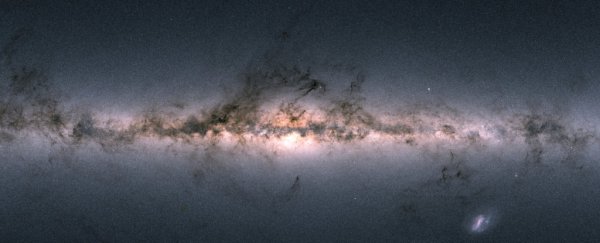We often think of space as peaceful and serene. In reality it's filled with violent events, including collisions on the galactic scale. We know our own Milky Way has likely smashed up with other galaxies in the distant past; now astronomers have revealed that one particular collision resulted in a mysterious feature called the 'thick disc'.
It occurred about 10 billion years ago, and was almost solely responsible for the stars in the inner halo - the dome-like structures that extend above and below the galactic plane - as well as the increased thickness of the galactic disc.
The Milky Way's halo is not like the ones of other spiral galaxies. Compared to others, the stars that are scattered throughout are remarkably poor in heavier metals.
This is a characteristic of very, very old stars, since metals were only propagated throughout the Universe after the first generations of stars that forged them had died, spewing their contents into surrounding space to be incorporated into the formation of new stars.
Astronomers have long thought that the Milky Way had several small collisions that fed stars into the halo, but that they didn't occur recently; in fact, not for over 10 billion years (the Universe is 13.8 billion years old).
But thanks to the recent release of Gaia data - the most detailed and accurate map of the sky to date - a team of astronomers has been able to make much more detailed observations of the stars in the inner halo.
They discovered the bulk of these objects came from a single source - and that source was another galaxy. The team has named that galaxy Enceladus, and the below video shows a simulation of its collision with the Milky Way.
"The motions of stars in the inner Milky Way's halo as measured by Gaia reveal the presence of a single large "blob" or kinematic structure. When we examined the chemical composition of the stars in this structure, we found a very well defined chemical sequence which only happens if the stars were born in the same system (and beyond the Milky Way)," astronomer Amina Helmi of the University of Groningen in the Netherlands explained to ScienceAlert.
"There may be other objects also contributing stars to the halo, but none is as large as this one. It really dominates the inner halo."
This evidence of that ancient collision has helped solved a long-standing mystery: that of the Milky Way's thick disc.
This is a feature seen in some spiral galaxies, and astronomers don't really know how they got there. In the Milky Way's case, the galactic disc can clearly be classified as two distinct parts: the thin disc, which is about 400 light-years thick, containing gas, dust and stars; and the thick disc, which extends to 1,000 light-years, containing only stars older than 10 billion years, like the inner halo stars.
The team's modelling suggests that a collision with a satellite dwarf galaxy roughly the size of the Small Magellanic Cloud would have both populated the Milky Way's halo with stars, and heated the pre-existing thin disc, expanding it into a thicker one.
The evidence for Enceladus the galaxy is strong. Helmi and her team found 13 globular clusters they were able to associate with the dwarf galaxy, based on their orbits and the compositions of their stars.
Research conducted based on the older Gaia data release also made a similar finding - that sometime between 8 and 11 billion years ago, the Milky Way collided with a satellite galaxy that injected stars into the inner halo and inflated the thick disc.
There's now more work to be done, trying to locate the stars left over from other collisions - and learning more about the Enceladus event.
"The next steps are to characterise the galaxy Enceladus better, and also the proto-milky Way now that we know how to separate the two," Helmi told ScienceAlert.
"It will give us unique insights on how galaxies looked like in the early universe and at high redshift, insights that are not possible to obtain by imaging those galaxies with Hubble, for example."
She also added that it's a tremendously exciting result, because now we know something new and deeply significant about our home galaxy.
"We did not know what the history was, we didn't know if most of the halo was made up of stars born in the Milky Way or elsewhere, and we didn't know how the thick disk had formed," Helmi explained.
"This was such a significant event in the history of the Milky Way! It's amazing that we now know this… that's very exciting."
The team's research has been published in the journal Nature Astronomy.
